Building the Unknowns
Design studies for covert strategic reconnaissance vehicles, 1951-1955
This timeline is intended as a framework for the examination of the intriguing interaction of US Cold War covert reconnaissance programs with the UFO phenomenon. Was Avro Canada's "Project Y" supersonic flying saucer project an unknown factor in the story of the U-2? Did certain Air Force officers push its development because of its possible utility as the "perfect reconnaissance vehicle" - one that would be disguised as a UFO?
1948
December
- Top Secret US Air Force Intelligence Division Study 100-
203-79 reviews UFO data collected to date. Noting a concentration of
sightings around strategic locations such as nuclear facilities and
industrial areas, and speculating on some unknown breakthrough in
propulsion or aerodynamics, the report advances the theory that UFOs
might represent unconventional Soviet vehicles conducting overflights
of the US for training, reconnaissance, or provocation purposes.
1950
Sept - USAF Scientific Advisory Board (AFSAB) studies means of "Pre-Hostilities" strategic reconnaissance of the USSR and other denied areas. Considers manned aircraft of various types, reconnaissance satellites, modified cruise missiles, balloons, and other exotic vehicles as camera platforms. Concludes that only stratospheric-altitude "constant-level" balloons can accomplish the goal in a short period of time at reasonable cost and with minimum provocation. Dr H P Robertson is member of AFSAB in 1950-51.
9
Oct - AF initiates Project GOPHER strategic reconnaissance balloon
system. AF Cambridge Research Center involved.
1951
February - Office of Naval Research's Urner Liddel begins anti-UFO publicity campaign. He argues that study of UFO reports indicate that ONR Skyhooks have caused almost all important UFO reports to date. Look's article:
Flying saucers were, and are undeniably real. They are part of a basic research program of the Federal Government which is as important, if not so dramatic, as the visitation from Mars feared by an imaginative public.
The flying saucer is the base of a huge balloon, 100 feet in diameter, called a 'Skyhook.' It is seen by earthlings traveling at speeds up to 200 miles per hour at heights up to 19 miles.
Mid-year
- Project BEACON HILL begins at MIT as subset of Project
LINCOLN air defense project, when AF Deputy Chief of Staff / Development,
Maj
Gen Gordon Saville, adds 15 reconnaissance experts to LINCOLN. By the
end of the year, this group had met in Boston at a secretarial school
on Beacon Hill, which gave code name to project.
Chairman
- Carl Overhage, Kodak. Other members included James
Baker and Edward Purcell, Harvard; Saville Davis, national editor of
Christian Science Monitor; Allen F. Donovan, Cornell Aeronautical
Laboratory; Peter Goldmark, VP CBS Laboratory (TV expert, in 1960s
designed camera for Lunar Orbiter); Edwin "Din" Land, Polaroid
founder; Richard Perkin, Perkin-Elmer (optics - P-E later built mirrors
for reconnaissance satellites, Hubble space telescope); Stewart Miller,
Bell Labs; Louis Ridenour, Ridenour Associates (fmr MIT Rad Lab).
Wright Field's reconnaissance representative to BEACON HILL was Col
Richard Leghorn. (Welzenbach, Pedlow - CIA U-2 history)
July
1951 - Leghorn, new chief of Wright Field Reconnaissance
Systems Branch, drafts "Comments on Intercontinental
Reconnaissance Systems, 1952-1960":
Recent analyses have established that certain objectives must
be sought in reconnaissance systems. These objectives fall
broadly in two groups....Pre-'D'-Day Reconnaissance and Post
'D'-Day Reconnaissance. A short intense [nuclear strike]
campaign as contemplated by SAC requires the collection of as
much planning information as possible prior to 'D'-Day. As the
SAC striking capability improves with the improved development
of atomic weapons and high performance, invulnerable vehicles,
need for Pre-'D'-Day intelligence assumes even greater relative
importance.....Vehicles for Pre-'D'-Day Reconnaissance must meet the
following requirements:
1. Minimum chances of detection.
2. Minimum chance of interception.
3. An unmanned vehicle is greatly preferred.
4. The vehicle configuration must lend itself to a 'cover plan'
excuse such as a scientific or weather mission gone
astray.Whether or not the State Department will acquiesce in the use
of any of these vehicles, the Department of the Air Force
must fully develop a technical capability for Pre-'D'-Day
Reconnaissance....
Leghorn
reviews advanced recon vehicle possibilities considered earlier by AFSAB,
such as satellites, the GOPHER balloon recon program, Snark and Navaho
cruise missiles with recon payloads, drone aircraft, RB-47, and air-launched
versions of the above using B-36 launchers. (Merton Davies, William
Harris, Rand's Role In The Evolution of Balloon and Satellite Observation
Systems and Related US Space Technology)
10
Sept - RAND establishes TS study project for Leghorn:
"Detectability-Vulnerability Study of Pre-Hostilities Air Recce
Techniques." RAND "considered means of reducing the detectability
of
high-altitude balloons, and the residual physical and political
vulnerabilities of sustained overflight programs." ("RAND's
Role")
same
day - Ft Monmouth radar/visual UFO incidents that provoke
Director of AF Intelligence, Gen Charles Cabell, to demand increased
emphasis on Project GRUDGE UFO study at Air Materiel Command's Air
Technical Intelligence Center (ATIC)
3
Oct - White House announces detection of "Joe 2" - second
Soviet
nuclear test, which had taken place on 24 Sept.
19
Oct - USAF signs contract with General Mills for development of
operational GOPHER strategic reconnaissance balloon system.
October
- Avro Canada's John Frost creates Special Projects Group to
develop VTOL concepts
November
- Lockheed Asst Chief Engineer Clarence L "Kelly"
Johnson (CLJ) night sighting of flying-wing-like UFO near his ranch
at Agoura, CA. (CLJ sketch in Blue Book 16 Dec 53 case file)
1952
Jan
- Feb - BEACON HILL group travels to various airbases, labs, and
firms for briefings on the latest technology and projects related to
reconnaissance. "The panel members were particularly interested
in
new approaches to aerial reconnaissance, such as photography from
high-flying aircraft and camera-carrying balloons. One of the more
unusual (albeit unsuccessful) proposals examined by the panel was an
'invisible' dirigible. This was to be a giant, almost flat-shaped airship
with a blue-tinted, nonreflective coating; it would cruise at an altitude
of 90,000 feet along the borders of the Soviet Union at very slow
speeds while using a large lens to photograph targets of interest.
Panel
studied many of the unique air vehicles mentioned the previous
year by Leghorn, and even considered ultra-long-range aircraft
powered by jet engines using heat generated by polonium-210
radioisotope. (Dwayne Day)
After
completing these briefings at the end of February 1952, the
BEACON HILL study group returned to MIT, where the panel members
spent the next three months writing a report detailing their
recommendations for ways to improve the amount and quality of the
intelligence being gathered on the Soviet Bloc.
7
Mar - BEACON HILL suggests that Project GRUDGE use acoustical
equipment to track UFOs (Story)
14 Mar - Project GRUDGE renamed BLUE BOOK
26
Mar - Project BLUE BOOK officer Capt Ruppelt and ATIC Col Kirkland
spend a day briefing BEACON HILL (Ruppelt, Sparks)
Spring
- At one of Ruppelt's UFO briefings, Air Defense Command Col
Methany proposes Operation POUNCE: modifying a unit of 12 new
Lockheed F-94C Starfires with camera package in nose in place
of A-A
rockets. Units would be based in hot sighting areas with two a/c on
24-
hr alert. The special UFO interceptors would hopefully be able to close
on a UFO and obtain close-up photos. Plan seriously considered by ADC
and rejected only because new F-94Cs still too scarce.
14 April - General Mills launches first GOPHER balloon with full camera package from Minneapolis.
30 April - second GOPHER test flight with camera successfully returns film with 20 exposures from 70,000 feet.
21
May - Coral Lorenzen sighting in Sturgeon
Bay, WI of probable
Project GOPHER reconnaissance balloon prototype. She publishes
article speculating that brilliant light on "UFO" might be
used for some
type of "high altitude photographic technique." Lorenzen begins
increased emphasis on publication of Aerial Phenomena Research
Organization (APRO) Bulletin. APRO is one of the earliest formal UFO
groups, becomes one of the largest.
15
June - "USAF Project LINCOLN, BEACON HILL Report: Problems of
Air Force Intelligence and Reconnaissance," MIT (S)
Report advocated radical approaches to obtain the information
needed for national intelligence estimates. Its 14 chapters covered
radar, radio and photographic surveillance, examined the use of passive
infrared and microwave reconnaissance, and discussed the
development of advanced reconnaissance vehicles.One of the report's key recommendations called for development of
high-altitude reconnaissance aircraft.We have reached a period in history when our peacetime knowledge
of the capabilities, activities and dispositions of a potentially hostile
nation is such as to demand that we supplement it with the
maximum amount of information available through aerial
reconnaissance. To avoid political involvements, such aerial
reconnaissance must be conducted either from vehicles flying in
friendly airspace, or - a decision on this point permitting - from
vehicles whose performance is such that they can operate in Soviet
airspace with greatly reduced chances of interception or
detection.(CIA U-2 history)
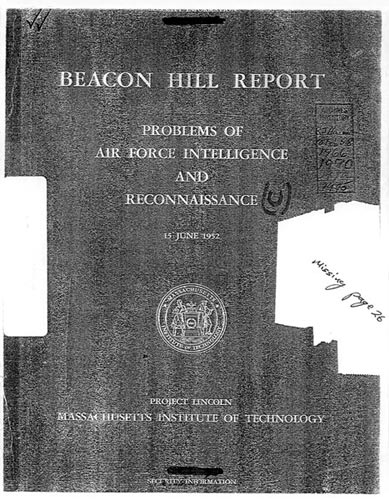
July
- Avro's Frost proposes Project Y "spade-shaped" supersonic,
ultra-high-altitude, VTOL fighter concept to Hawker Siddeley management.
Patent filed in UK in August. Design work and construction of full-scale
mockup begin in Toronto.

October
- Draft memo to Psychological Strategy Board from DCI W B Smith,
transmitting CIA official's Chadwell's conclusions to National Security
Council: "I suggest that we discuss
at an early board meeting the possible offensive or defensive
utilization of these phenomena [UFOs] for psychological warfare purposes."
1953
14-17
Jan - CIA Scientific Panel on Unidentified
Flying Objects chaired
by Dr H P Robertson. Attendees include CIA Office of Scientific
Intelligence (O/SI) Asst Director H Marshall Chadwell, O/SI Deputy Asst
Director Ralph Clark, O/SI Operations Staff Chief Philip Strong (Col,
USMC Reserve), USN Photo Interpretation Center personnel Neasham
and Woo. The activities of amateur UFO investigative groups like APRO
are mentioned with apparent concern in panel report.
23
Jan - Lockheed propulsion expert Nathan Price files patent application
for
high-altitude, supersonic propane or liquid-hydrogen-powered saucer.
27 Feb - British Flight magazine item: "Flying Saucers. Stories of these mysterious vehicles are legion; only rarely, however, is such a report coupled with the name of a manufacturer. Particular interest is, therefore, attached to the following two announcements. In the first case, Radio Belgrade stated that that a number of flying saucers flew over a Belgrade suburb on February 15th. They were, it appears, developed by the research department of the Jugoslav Air Force and had the following characteristics: diameter, 40 in; all-up weight, 4 1/2 lb; top speed, 31 mph with radio control. A further display is 'scheduled for Marshal Tito's birthday.' The second report is of a much more ambitious project. No less a firm than Avro Canada is involved, for at their Malton, Ontario, factory they are alleged to have a wooden mock-up saucer under 'super security' guard. Reports have it that the diameter will be 40 ft, the speed 1,500 mph and that vertical take-off will be possible. Plans of the project have 'been studied by the British Air Ministry.'" (Tito's birthday is May 7; He visits Britain in March. http://www.titoville.com/filmography.html)
March
- Avro Project Y saucer wind tunnel tests at RAF Woodford
validate Frost's engine and aerodynamic concepts. Hawker Siddeley chairman
Sir Roy Dobson personally approves development.
27
Mar - Wright Air Development Center (WADC) Bombardment Branch New
Developments chief William Lamar and engine expert Maj John Seaberg
draft requirement for design study for new high-altitude
reconnaissance aircraft conforming to BEACON HILL ideas. ARDC
superiors agree on suggested approach: to bypass the big aircraft
contractors for this specialized a/c. Project codename BALD EAGLE.
(Miller, "U-2") Seaberg works at WADC with German Paperclip
engineers Woldemar Voigt and Richard Vogt (ex-Arado), who were
experts on high aspect-ratio wings. Air
Research and Development Command (ARDC) Reconnaissance Division,under
Lt Col Joseph Pellegrini, is responsible for approving all new AF recon
aircraft designs. (CIA U-2 history)
April - RAF Flying Review article on Avro saucers - "Man Made Saucers."
21 - 24 April - London Times and Toronto Star articles on Project Y.
May - The Aeroplane and Air Pictorial publish articles on Project Y
June - Swiss aviation magazine Interavia article on Project Y
1
July - Seaberg and Lamar give study contracts to Bell Aircraft (X-
16), Fairchild (MX-2147) and Martin (RB-57) for BALD EAGLE aircraft
competition.
15 July - French aeronautical engineer Michele Wibault, living in US, files US patent for saucer-like "Aircraft With Enclosed Rotor" or "Gyropter," which will become direct ancestor of Hawker Siddeley Harrier VTOL fighter-bomber.
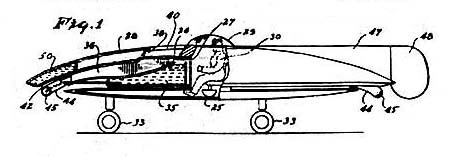
July - CIA has been pushing for more UK involvement in reconnaissance overflights. CIA-backed RAF Canberra reconnaissance overflight of Kapustin Yar from West Germany to Iran. "The whole of Russia had been alerted by the thing and it damned near created a major international incident" - Robert Amory. Results in increased interest in developing high-performance covert reconnaissance platform. (Burrows, Deep Black)
mid-53
- AFSAB Intelligence Systems (or Reconnaissance) Panel - ex-
BEACON HILL members Baker, Donovan, Land, "a few others."
(Putt is
military director of AFSAB) "Phil Strong became associated, since
he
was brought in to advise the ISP of the yawning gaps in US intelligence
[Strong is AFSAB member 1954-60]. Since he was chairman of the ISP,
the USAF asked Jim Baker to visit some aircraft companies and seek
their views on high-altitude aircraft. Strangely, though, Baker was
not
asked to visit Bell, Fairchild or Lockheed." (Pocock)
12 Aug - first Soviet thermonuclear test
21
Aug -Strong drafts O/SI memo, "Reconnaissance Capabilities"
(CIA
U-2 history)
25 Aug - Avro files US patent for Project Y saucer.
15
Sept - ARDC Cdr Lt Gen Donald Putt, along with Dr A G Hill, chief of
AF Lincoln Laboratory (and a signatory of the BEACON HILL report), and
Dr J Marchetti, Technical Director of AF
Cambridge Research Center, visit Toronto, meet Dr O M Solandt
Canadian Defense Research Board head, visit Avro Canada plant, view
"Project Y" mockup. (New York Times)
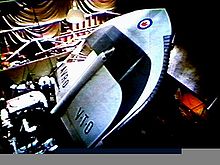
30
Sept - Project Blue Book Report 12 mentions Putt's visit to Avro,
provides a capsule history of Frost's efforts to sell USAF on the
project allegedly as far back as 1950.
11 Oct - New York Times article on Project Y. "The published stories [six months ago] caused consternation and regret among both A. V. Roe officials and the Royal Canadian Air Force, which had supplied technical assistance to the project. 'It was frightening that our most vital secret got out that easily,' said one company executive. The R.C.A.F. spoke of 'a breach of security.' Since then everyone has moved to draw the curtain tighter."
3 November - a US MOBY DICK balloon launched from Holloman AFB on 31 Oct reaches England and provokes sighting flap. ("Contributions of Balloon Operations at Holloman AFB," Good, Above Top Secret)
Nov - "Intelligence Digest," published privately in UK by a Mr Kenneth De Courcy, reports tale of East Bloc defector who said that on 26 July 53, people in towns and villages on the Baltic coast, along the Polish border, had seen round objects in formations of 6. On 31 July at 7 PM an object landed at Wolin - metal, 65 ft diameter, closed spherical center. "On the exterior was a flat circle in which were exhaust ports, like jets.... But no engine was visible, nor were any humans ... aboard, and there was neither sound nor movement. It is also alleged that this object bore Russian inscriptions." (cited in Wilkins, FS on the Attack)
30
Nov - Lockheed Corporation Development Planning Note #1,
"Strategic Reconnaissance and Intelligence" describes F-104A
fighter
modified with new engine and extended wings to provide extremely
high-altitude reconnaissance capability. (CIA U-2 history)
7 Dec - Radio Moscow announces that "Flying Saucers are figments of the imaginations of western warmongers designed to make taxpayers swallow heavier military budgets." (Edwards, FS, Serious Business)
Wed,
16 Dec - UFO Sighting by Kelly Johnson and wife Althea; at same time
airborne WV-2 Constellation AWACS aircrew on test flight
sees apparently the same object. The UFO is hovering over Point Mugu
NAS missile test range when first sighted. WV-2 pursues for a time
before object disappears in W. The Johnsons are at
their Lindero Ranch near Ventura at the time (BB case file).
Same
day - Article in People Today magazine on Putt visit to Avro.
Gives
fairly accurate sketch and details of the aircraft. Mentions Field
Marshal Montgomery's interest in mockup during earlier visit.
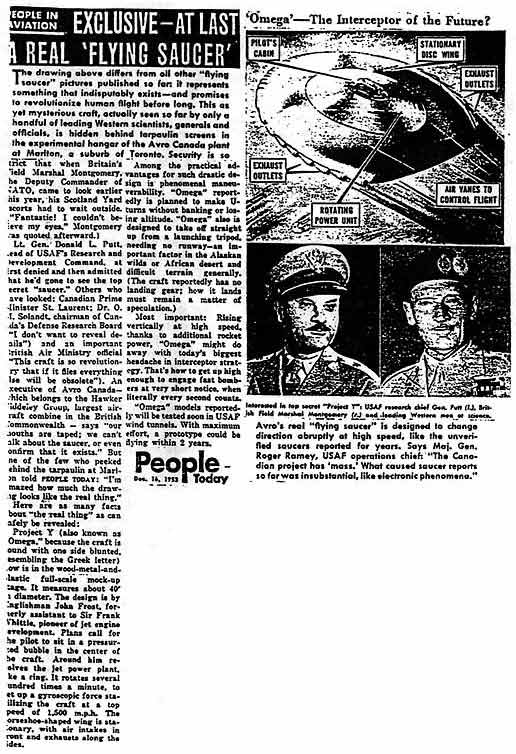
17
Dec - CLJ returns to work. Witnesses compare notes. WV-2 pilot
Rudy Thoren writes memo on sighting.
Philip
Strong visits California in "late December," enhances CLJ
interest in special recon a/c (Miller "Skunk Works"). Strong
and
Johnson are personal friends. (ibid) CLJ evidently immediately begins
actual design work on CL-282: "December 1953, We started an
investigation of wing area modifications and stripping procedures to
modify the F-104 airplane to get the maximum possible altitude for
reconnaissance purposes." (Johnson "Log for Project X"
quoted in
Miller, Skunk Works)
18
Dec - CLJ writes memo on sighting, attaches sketch of object and
similar object sighted in Nov 1951. (Blue Book file)
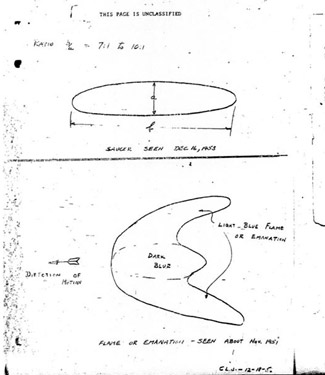
29 December - Maj Gen John Samford, AF Director of Intelligence, to Col George L Wertenbaker, ATIC chief, on Avro saucers.
It is my understanding that you are continuing an active interest in the 'Flying Saucer' being developed by the Canadians. Also, you may have knowledge of General Putt's reaction to their program from his recent trip to that country.
I would appreciate your analysis of this Canadian program. There is also an interest from both the possibility standpoint, and the time factor required by a foreign country to achieve results in this field.
If you so desire, we might be able through our contacts with the Canadians here, to arrange ATIC representation during this development, or phases thereof.
1954
11
Jan - Lockheed engineer Joseph Ware writes memo on the 16 Dec sighting
aboard WV-2. Mentions previous sighting at "1951 Christmas
holidays." Mentions visiting contactee George Van Tassel at Giant
Rock.
Same
day - Lockheed Chief Aerodynamicist Phil Colman writes memo on
his 16 Dec sighting aboard WV-2. (BB file)
20 Jan - CLJ cover letter to ATIC re sightings
Jan
- The three BALD EAGLE competitors submit studies to Lamar and
Seaberg at WADC. (Miller, U-2) Avro and Canadian Defense Research
Board approach USAF with proposal for AF funding of Project Y and Y2.
(ARDC Ladybird Project Card)
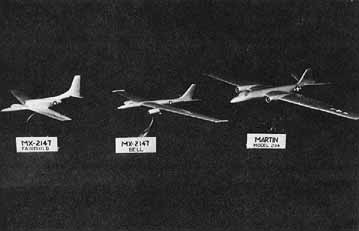
February
- "I was told of Air Force interest that would be
developed with an airplane having the characteristics we were finally
able to obtain on the F-104A study." (CLJ "Log for Project
X")
15
Feb - Gen Putt (outgoing ARDC Cdr) forwards Lockheed UFO sighting report
file to Col Wertenbaker at ATIC with cover note mentioning Johnson's
extreme reluctance to file the reports due to his concern that it would
jeopardize his reputation and acceptance of his design submissions.
(BB file)
5
Mar - Lockheed completes Report 9732, describing the CL-282 high-
altitude aircraft. "This was a complete report, still tying the
high-
altitude airplane to the F-104." In report, Phil
LeVeille of Phil Colman's preliminary design group wrote, "This
report
presents information on the design of an aircraft capable of flight
at
an average altitude of 73,000 feet with a combat radius of 1,400
nautical miles. The objective of the design is to accomplish this
performance with a relatively small airplane and with a non-jettisonable
military payload of 600 pounds....The airplane has no landing gear;
takeoff being accomplished by the use of a ground cart...." (Miller,
Skunk Works)
Early
Mar - CL-282 proposal sent to Gen Bernard Schriever, in DPO,
Pentagon. Lockheed exec L Eugene Root had worked at DPO until
shortly before. Root was also AFSAB Aerospace Vehicles Panel
member in 1954.
Mar - British engineer Randolph Samuel Rae submits "Rex-1" proposal for ultra-high-altitude hydrogen-powered propeller aircraft to ARDC, WADC. (Sloop, Liquid Hydrogen As A Propulsion Fuel)
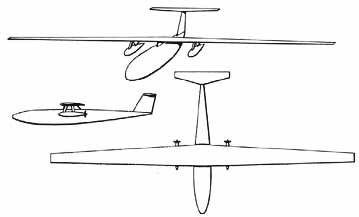
Early
Apr - CLJ pitches CL-282 to group of Generals in Pentagon,
including Putt (now AF Deputy C-o-S for Development). Interest cool.
They want more conventional aircraft with potential offensive
capabilities. (Pocock)
Apr
- Seaberg at Wright Field selects Martin RB-57 version of British
Canberra as prime contender for BALD EAGLE. Flies to Baltimore to brief
new ARDC cdr, Lt Gen Thomas Power, on the three
contenders. (Miller, U-2)
"Because
of Johnson's ability to move freely within the confines of the
DoD and intelligence communities, his long-standing friendship with
CIA's Phil Strong proved an important foot in the door during the
critical decision making that led to the program hardware contract.
While work on the Bell Model 37 and Martin RB-57D moved ahead rapidly
under the direction of the Air Force, Strong and another CIA associate,
Richard Amory saw, with a little prompting, that Lockheed's CL-282
had merit..." (Miller, Skunk Works)
12
May - "Trevor Gardner and two colleagues invited Phil Strong to
Pentagon and brief him on CL-282 and BALD EAGLE designs. They asked
him if the CIA would throw its weight behind the project. Strong
discussed the designs with the AFSAB Intelligence Systems Panel.
Donovan thought the B-57 would be far too heavy...Baker suggested
that Donovan should visit Lockheed to learn more about the CL-282."
(Pocock) Strong drafts O/SI memo, "Special Aircraft for Penetration
Photo Reconnaissance" (CIA U-2 history) Strong first approaches
newly-hired CIA official Richard Bissell with details of the Lockheed
plan
for a high-altitude a/c. Bissell, immersed in the Guatemala operation,
is
interested but preoccupied. (ibid) Strong agitates for DCI Dulles to
pressure AF to conduct overflights of Soviet Kapustin Yar missile
flight test range. AF declines. (ibid)
18
May - Seaberg receives CL-282 proposal at WADC. He is not thrilled.
"Johnson had acquired the confidence of many high ranking military
personnel. He was accustomed to dealing with them at all levels of the
bureaucracy. It was almost inevitable, as far as Seaberg was
concerned, that someone in the Pentagon would take the liberty of
telling Johnson about the classified high-altitude reconnaissance
aircraft proposal." (Miller, U-2)
CLJ
has also approached Joe Charyk at CIA [?-disputed by Dwayne Day]
with the proposal. Charyk was responsible for technological collection
programs of the type represented by the CL-282 according to Miller.
(Miller, U-2)
20
May - Asst Director O/SI H Marshall Chadwell memo to OSI Applied
Science Division and OSI Physics and Electronics Division, requests
a
determination as to which O/SI division would be responsible for dealing
with intelligence on Soviet "Non-conventional Vehicles" of
Avro saucer
type. (CIA online documents)
21 May - Avro Aircraft (UK) chairman Sir Roy Dobson letter to Minister of Supply Duncan Sandys concerning ARDC's urgent interest in funding Project Y and derivatives. Dobson says that Avro has tried to "tone down" ARDC interest in the program due to its early stage of development and possible interference with British and Canadian interest in the project.
31 May - Time magazine article on Project Y, Frost, Air Force interest in developing the project, and fears of possible Soviet progress along similar lines.
same day - letter from British High Commission in Ottawa to Ministry of Supply, London, concerning Avro's irritation over leak to Time coming from Washington (see 21 May).
7
June - Hq USAF rejects CL-282. Later in the month Seaberg rejects
too due to inadequate J73 engine.
CLJ
begins redesign of CL-282 for J57 engine, approaches Trevor
Gardner, AF Assistant Sec for R&D, with proposal. (Miller, U-2)
11 June - Colliers article: "A Report on our 'Flying Saucer' Balloons," by Charlotte Knight of Air Force Magazine.
14
June - O/SI "Intelligence Responsibilities for Non-Conventional
Types
of Air Vehicles" memo assigning responsibility for analysis of
intelligence on the discovery of a Soviet equivalent of Avro Y2 saucer
to Applied Science Division under Sidney Graybeal, mentions that CIA
UFO files would continue to be maintained by Physics and Electronics
Division under Todos Odarenko. (CIA online documents)
June - July - Review and evaluation of Avro Project Y2 vehicle by USAF. Specifications: Diameter 29.2 ft; Gross wt 29,000 lb, thrust, 43,000 lb w/o afterburner; ceiling 71,000 to 80,000 ft; Max speed Mach 3.48 (ARDC Ladybird R&D Plan)

13
Aug - ARDC issues "Technical Requirement 3" for Avro Mach
3
ultra-high-altitude saucer-like research vehicle based on Y2 design.
AF
procurement plan number MX-1794, code name LADYBIRD.
July - Sept - Dr James Doolittle study of covert activities: "...an aggressive covert psychological, political and paramilitary organization more effective, more unique and, if necessary more ruthless than that employed by the enemy...[E]very possible scientific and technical approach to the intelligence problem" should be explored. (Ranelagh, The Agency)
Sept - Bell begins fabrication of X-16 BALD EAGLE components.
15
Sept - ARDC Project Plan for MX-1794 LADYBIRD. William Lamar is
Project Engineer at WADC (see 27 Mar 53). Gen Homer Boushey signs
off on plan. Boushey had been Loedding's superior circa 1941.
16 Sept - British Ministry of Supply PDSR(A) (E J Jones) memo to Minister Sandys re Project Y noting that "I have spoken briefly with Sir Roy Dobson and Mr. Trevor Gardner.... I have their assurances that, if the U.S.A.F. did sponsor the project, this would not prevent AVRO (Canada) from retaining their rights in maintaining a full exchange of information with us." (PRO AVIA 65/33 file)
10
Oct - ARDC issues detailed Project Card (specifications) for Avro
LADYBIRD.
Huge French UFO flap - Sept-Oct peak. Wave extends into other European countries in following weeks.
18 Oct - " A London evening newspaper asserts that monkeys in oxygen masks and helmets, used in cosmic ray test balloons, account for series of [reports of] queer beings in landed saucers" (Wilkins, FS Uncensored)
Oct - Romanian, Hungarian papers criticize US drive to induce "flying saucer psychosis" in their countries, and claim that reports are invented by capitalist warmongers. Red Star, Red army paper, denounces UFOs as capitalist propaganda (Ruppelt)
27 Oct - "Yugoslavia officially announced that a serious investigation of UFOs would be undertaken in that country. On the preceding Monday a strange object had been observed over that country by astronomers, meteorologists, and pilots, as well as average citizens." (Lorenzen, UFOs Whole Story)
28 Oct - "A Yugoslavian scientist asserts that seven flying saucers [seen recently] must be secret weapons of the United States or Russia." (Wilkins, FS Uncensored)
5
Nov - Edwin Land and 3 other scientists write urgent TS letter to
Allen Dulles urging development of the CL-282. "The Lockheed super
glider will fly at 70,000 feet, well out of reach of present Russian
interception and high enough to have a good chance of avoiding
detection. The plane itself is so light (15,000 lbs), so obviously
unarmed and devoid of military usefulness, that it would minimize
affront to the Russians even if through some remote mischance it
were detected and identified." (Pocock, "Peshawar to Bodo")
November
- AFSAB Aerospace Vehicles and Propulsion panels joint
meeting to discuss Avro Y2/Ladybird
saucer vehicles. At this time the
Aerospace Panel members included BEACON HILL veteran Allen Donovan
and the Propulsion Panel included William Rannie and Addison Rothrock,
who signed off on the ARDC Project Plan for LADYBIRD, and L Eugene
Root of Lockheed. But more importantly, the 1954 AFSAB Intelligence
Systems
(Reconnaissance) panel included three very significant BEACON HILL
veterans: Chair Jim Baker; Allen Donovan - who in his Aerospace
Vehicles Panel capacity was reviewing LADYBIRD - Edwin Land and Carl
Overhage. O/SI's Philip Strong was AFSAB member as well. Here is
where LADYBIRD officially crossed paths with BEACON HILL. (The USAF
Scientific Advisory Board: Its First Twenty Years, 1944-1964)
According to CIA O/SI head Herbert Scoville, the three-man SAB committee "found that several factors had been overlooked or minimized in their development, such as payload, drag factors, and mechanical design problems, to such an extent that the committee recommended against support for the project." (Scoville memo to DCI Dulles, October 1955)
9
Nov- Trevor Gardner visits CLJ and Robert Gross at Skunk Works to
view CL-282 mockup. (Miller, U-2)
18
Nov - Seaberg briefs Killian committee of about 15 distinguished
scientists (including Land) in Putt's Pentagon office on Bell, Martin,
Fairchild entries in high-altitude recon competition. Lockheed concept
also mentioned. Seaberg was late - Gardner had already been pushing
the design, as had Philip Strong. (Miller, Skunk Works)
24
November - Eisenhower receives both Dulles brothers, Putt, and
Sec Def Charlie Wilson with CL-282 proposal backed by Killian
Committee. Ike approves the development of the a/c system.
The
next day Richard Bissell is summoned by Charyk to Allen Dulles's
office and given the job of managing the system's development.
Present were Putt, Trevor Gardner, etc. They phone CLJ and give go-
ahead for 20 a/c. Development would be conducted under some of the
most stringent security for a technical program since the Manhattan
Project.
DCI Dulles calls US Intelligence Board meeting to bless project.
9 Dec - CL-282 contract signed. Codename AQUATONE.
Bissell
"appointed a steering group including Gardner, Gens Cabell and
Donald Putt." (Beschloss)
December
issue of USAF "Air Intelligence Digest" is devoted to
LADYBIRD.
While never mentioning the name Avro, the article shows illustrations
of the LADYBIRD high-mach saucer and asks intelligence personnel to
ponder the question "What if the Soviets have saucers with this
kind
of performance?" "Conclusion: Heads Up!"
However, the development of the Y2/MX-1794 vehicle has been effectively throttled after the unfavorable SAB review:
3 Dec - Canadian Defense Ministry announces that Avro saucer project was being abandoned "although a number of subassemblies had been built" (New York Times)
16 Dec - at press conference, Eisenhower says that it is completely inaccurate to believe that flying saucers are coming from outer space.
1955
7 Jan - AF Information Services Letter: "People in the AF are talking too much about UFOs - shut up" (Ruppelt)
17
Jan - ARDC cancels TR3/LADYBIRD requirement. Project continues at
lower level of emphasis as SILVER BUG. Lamar is still project monitor.
Seaberg occasionally attends meetings.
16 Feb - WADC and ATIC issue joint report on Project 9961, SILVER BUG.
31 April - member of Soviet Academy of Sciences denounces UFOs in media after spate of stories about Tunguska as "crashed Martian spaceship" (New York Times; Ruppelt)
1 Aug - CLJ's CL-282 "Angel," now designated U-2, makes first flight at Area 51, Groom Lake. AQUATONE unit "patch" motto is "Toward the Unknown"
8 Aug - memo from William Lamar, WADC SILVER BUG project officer, to Avro:
The advantages and disadvantages of a press release on the subject contract are still under consideration by the USAF. The disadvantages currently appear to overcome the advantages, but the matter of a press release has not died completely. It is considered advisable, therefore, to have a news item prepared and coordinated in the event instructions to release it are received. The release proposed by WADC is as follows:
The air force announced today it has signed a research and development contract with AVRO Aircraft ... to obtain analytical design and test results of a proposed new aircraft. Size of the contract is approximately $785,000.
(WS-606A Files)
24 Aug - release appears in New York Times
4
Oct - Senator Richard Russell and party
sight two UFOs similar to
Avro LADYBIRD lifting off from remote location in Azerbaijan. O/SI
memos note similarity to Avro design.
25
Oct - Project Blue Book "Special Report 14" statistical survey
of
UFO data is released to media by AF Sec Donald Quarles, associated with
material describing Avro saucer, strongly implying that the advanced
Avro saucer was on verge of flight test. In following weeks media is
filled with stories proclaiming that if UFOs are sighted, they will
be advanced aircraft
manned by USAF pilots - Avro's LADYBIRD.
1956
10 Jan - First wave of Genetrix reconnaissance balloons launched for USSR overflights.
3 Feb - Genetrix balloon from Gardermoen, Norway causes UFO reports in Oslo.
6 Feb - After Soviet protest on 4th, Eisenhower issues orders to halt Genetrix launches.